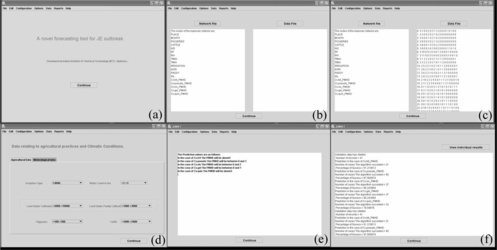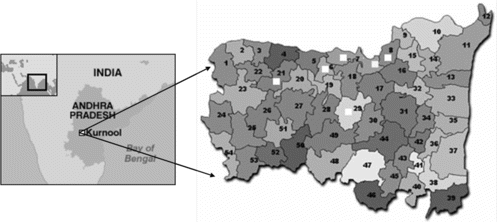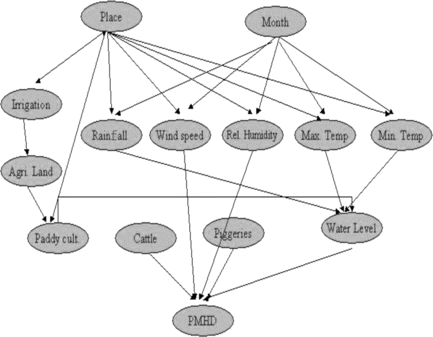Abstract
Japanese encephalitis (JE), a complex viral disease transmitted by mosquitoes. Determination of vector (mosquito) density is a prerequisite for devising effective control measures against this disease. Bayesian network is a widely used tool that has recently found application in the epidemiological surveillance studies. This article describes the application of Bayesian network tool to predict the Japanese encephalitis vector density using the longitudinal data collected from the Kurnool district of Andhra Pradesh, India, from 2001 to 2006. The entomological parameter from the study area indicates that various contributing factors are responsible for the prevalence of these vectors, making it difficult to estimate the importance of any particular parameter contributing to the increase of vector density. The application of this approach resulted in 73.12% to 95.12% accuracy compared to the test data with the corrected data.
The Bayesian network has gained popularity in clinical epidemiology for the construction of appropriate disease models and diagnosis (Dunson and Baird, Citation2001; Heckerman, Citation1991), interpretation of microarray gene expression and prediction operons (Bockhorst et al., Citation2003), weather forecasting (Abramson et al., Citation1996), and disease outbreaks (Tsui et al., Citation2003). This technique offers the possibility of an extensive statistical treatment of complex epidemiological models including inference about model parameter values, calculations of confidence intervals for model predictions, model checking, and hypothesis testing (Cancre et al., Citation2000). A Bayesian model has been used for prioritization and identification of communities requiring ivermectin treatment in Amazonian (Carabin et al., Citation2003). Along similar lines, the present study describes development of a Bayesian model that has been developed for predicting vector density (per man hour density (PMHD)) of Japanese encephalitis (JE) mosquitoes in the Kurnool district of Andhra Pradesh, India.
MATERIALS AND METHODS
Study Area and Eco-Climatic Condition
The Kurnool district of Andhra Pradesh, India was selected for the present study because the highest number of JE cases were reported from this region since 1996 (Figure ). The area is located between 15.83°N, 78.05°E. Most of the population is affianced in agricultural practices. Patchy paddy fields and water loggings are commonly seen in and around Kurnool district. Domestic animals commonly share the habitat with the human population. This district is generally warm and humid during most parts of the year. These factors were considered for this study because of their direct or indirect contribution towards the development of the prediction model of Japanese encephalitis vector density.
Data Collection
Data was collected from six regions (5 rural and 1 urban) reporting incidence of JE comprising of Peddathumbalam, Nandanapalli, Nandikotkur, Gudur, Cherukulapadu, and Kurnool urban areas from 2001 to 2006. The collected data consists of entomological, agricultural, and meteorological data and was used for the construction of the Bayesian network.
Vector Surveillance
Vector surveillance was initiated in all six index areas to know the seasonal prevalence of JE vectors. The mosquito population was sampled during dusk hours (6:30 PM to 7:30 PM). Indoor and outdoor resting mosquitoes were collected from the fixed cattle sheds every month with the help of mechanical aspirators (Hausherr's Machine Works, NJ, USA). Light traps were also used for sampling the vector population. The collected mosquitoes were separated species-wise and the relative density of female mosquitoes was recorded as the number of females collected per man hour (PMH). The captured mosquitoes were segregated into different pools (50 mosquitoes per pool) and were screened for infectivity towards Japanese encephalitis virus by the enzyme linked immunosorbent assays (ELISA) method (Gajanana, Rajendran, and Thenmozhi, Citation1995).
Collection of Agricultural and Meterological Details
In the study area, the entomological and epidemiological details were collected in addition to other details like agriculture in hectares, paddy cultivation in hectares, crops per year, crop seasons, irrigation sources, water stagnation period in paddy, types of fertilizers, summer crops, piggeries, cattle sheds, positive JE cases/deaths and vaccination details have been collected from the selected study areas. Meteorological conditions of the study areas were collected from the Indian Meteorological department, Hyderabad.
Japanese Encephalitis-Bayesian Network (JEBNET)
JEBNET carries out the prediction of the JE mosquito population in three phases.
Phase-1
This is the classical Bayesian network phase. To predict a child node in the Bayesian network, the program checks the values of the parent nodes provided and examines the database looking for all instances where the pattern of the values taken by the parent nodes matches the given set.
Phase-2
This is an extension phase and is used because the limited size of the database makes it highly probable that a given assignment tuple of values of the parent nodes has not been perceived before. In such a case, compute the value of the child and measure how much is necessary to disturb a state for which we know the exact solution. Next, how much this perturbation of the values of the parents affects the child node in general over the entire database was taken into account. Suppose the value of the child changes by the tuple A, and with the known pattern the value of the child is represented by the tuple B. Then the projected value of the child is given by the tuple A +B.
Phase-3
This final phase begins when the database contains neither a single record with the required assignment tuple for the parent nodes nor a single pair of records whose assignment tuples for the parent nodes vary by the required difference tuple. In this case, the difference tuple is split up into its components in the various coordinates and each difference is treated as a separate difference tuple. The shifts computed for the separate difference tuples are all added up to obtain the resultant shift, which is then added to the base value to obtain the predicted value.
JEBNET APPLICATION RESULTS
For a given set of parameters influencing a certain event, it sometimes happens that not all the parameters influence the occurrence of the event in a similar fashion. Some parameters might influence the occurrence of the event in a more direct way and some in an indirect way. For example, temperature, rainfall, and paddy cultivation are the important factors that directly influence the JE mosquito population, whereas other climatic factors such as relative humidity and wind speed indirectly affect their population. For the analysis using a Bayesian network, month, wind speed, rainfall, relative humidity, maximum temperature, minimum temperature, irrigation, agricultural area, area for paddy cultivation, water depth in paddy fields, piggeries, cattle sheds records were considered in predicting the density of mosquito population. The network primarily contains the information about relationship and interdependence variables. The Bayesian network designed for the above-collected parameters is shown in Figure .
The algorithm used in this model to predict the PMHD of JE mosquitoes is a slight modification of the Bayesian network algorithm and the preprocessing system is implemented on a PC platform using JAVA programming language. Figure shows the main window where the user may select the Bayesian belief network file, data files, selection of agriculture, meteorological parameters, and test data files.
FIGURE 3 The main windows of JEBNET. (a) JEBNET home page; (b) Selection of Bayesian belief network file; (c) Selection of data file; (d) Agricultural and meteorological details selection; (e) Prediction results of JEBNET; and (f) Comparison of results with test data.

This algorithm attempts to calculate the mosquito population that can occur with maximum likelihood.
This likelihood of an event is calculated as follows:
The JEBNET model uses a data file that contains the different parameters specified in the belief network file. The network file contains meteorological, agricultural, and animal parameters. The model was tested in a variety of ways to verify its value in all conditions. The test involved testing the overall performance of the model in terms of prediction of PMHD and its accuracy.
Information intercorrelating values of these parameters and giving the PMHD for the known and suspected mosquito vectors under the given conditions was provided. Data collected from Cherukulapadu, Gudur, Nandanapalli, Nandikotkuru, and Peddatumbalam of the Kurnool district of Andhra Pradesh from June 2002 to July 2004, giving a total of 69 known patterns, was applied for JEBNET.
The data was partitioned in such a way that data collected over a year was used as training data and the remaining data was used for testing the accuracy of the Bayesian network. The reason for using the data collected over a year for training the system was to make sure that the system was trained for all possible cases during the training data collected over the year 2002 and test data collected over the year 2003.
JEBNET also provided the percentage of accuracy of the prediction by species-wise and the results are shown in Table .
TABLE 1 Percentage of Accuracy by Species Wise of Prediction Results
CONCLUSIONS
This study presents a computational method, based on a Bayesian network, for predicting the PMHD of JE transmitting vectors. This method takes advantage of a variety of data sources including agricultural, meteorological, and animal data that were used to provide the density of vectors well in advance, which help in effective control of disease outbreaks. This method may assist the public health decision-makers to plan and implement disease and vector control interventions and to allocate public health resources more effectively and efficiently. Results of studies such as this may facilitate the development of a prediction model through a Bayesian network for reducing the incidence of this widespread Japanese encephalitis disease.
The authors are grateful to Director, IICT for his encouragement and support. The authors are thankful to the Indian Council of Medical Research (ICMR), New Delhi, for sponsoring and supporting the project.
REFERENCES
- Abramson , B. , J. Brown , W. Edwards , A. Murphy , and R. Winkler . 1996 . Hailfinder: A Bayesian system for forecasting severe weather . International Journal of Forecasting 12 : 57 – 72 .
- Bockhorst , J. , M. Craven , D. Page , J. Shavlik , and J. Glasner . 2003 . Bayesian network approach to operon prediction . Bioinformatics 19 : 1227 – 1235 .
- Cancre , N. , A. Tall , C. Rogier , J. Faye , O. Sarr , J. Trape , A. Spiegel , and A. Bois . 2000 . Bayesian analysis of an epidemiologic model of plasmodium falciparum malaria infection in Ndiop, Senegal . American Journal of Epidemiology 152 : 760 – 770 .
- Carabin , H. , M. Escalona , C. Marshall , S. Vivas-Martínez , C. Botto , L. Joseph , and M. G. Basáñez . 2003 . Prediction of community prevalence of human onchocerciasis in the Amazonian onchocerciasis focus: Bayesian approach . Bulletin of the World Health Organization 81 : 482 – 490 .
- Dunson , D. B. and D. D. Baird . 2001 . A flexible parametric model for combining current status and age at first diagnosis data . Biometrics 57 : 396 – 403 .
- Gajanana , A. , R. Rajendran , and V. Thenmozhi . 1995 . Comparative evaluation of bioassay and ELISA for detection of Japanese encephalitis virus in field collected mosquitoes . Southeast Asian Journal of Tropical Medicine and Public Health 26 : 91 – 97 .
- Heckerman , D. 1991 . Probabilistic Similarity Networks. Cambridge : MIT Press .
- Tsui , F. , J. Espino , V. Dato , P. Gesteland , J. Hutman , and M. Wagner . 2003 . A real time public health surveillance system . Journal of American Medical Informatics Association 10 : 399 – 408 .

